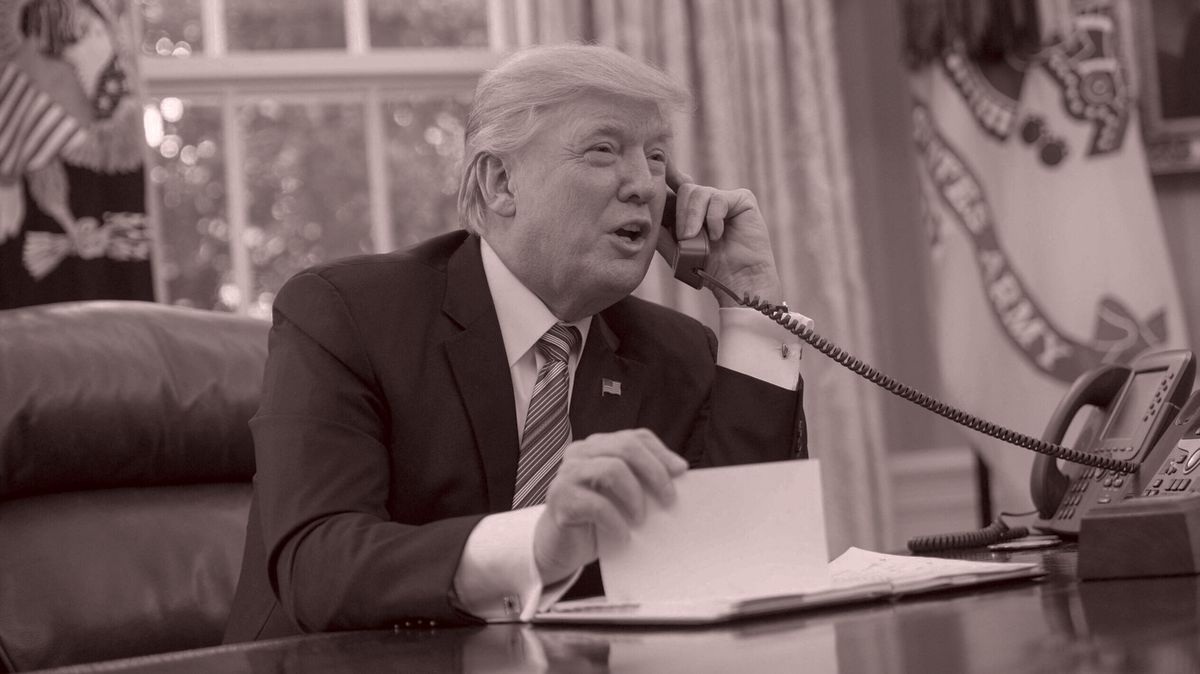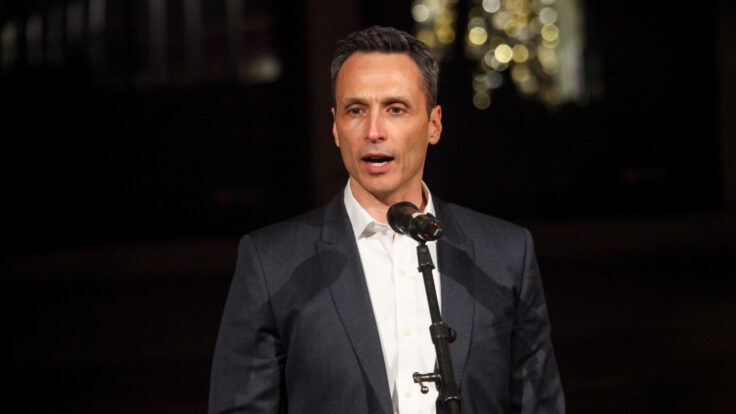Hello and welcome back to The Best & The Brightest. I’m Leigh Ann
Caldwell, driving the bus on another day in Trump’s Washington. In tonight’s issue, I zero in on how, exactly, House Speaker Mike Johnson advanced his budget framework: both because Trump intervened and because the centrists folded (again). New details on how it all went down, plus an analysis of the fights to follow, below the fold.
But first…
|
- The
DOGE endgame: Last night, I had a quick drink with a source whom I consider my most astute Trump interpreter, and asked about the endgame for DOGE. “To break shit,” this person said, simply enough. Yes, DOGE wants to save some money and rid the government of “woke” programs, but the real goal is to dismantle what America First philosophers like Russ Vought have called the administrative state potentially beyond repair. As if on cue, Vought—now the director
of O.M.B.—sent a memo to agency heads today requesting plans for “large-scale reductions” in staff by March 13, and by mid-April, proposals for offices to relocate outside of the Washington, D.C., area. (Trump doesn’t appear worried about the D.C. economy, where he won just 6.6 percent of the vote.)
My source also offered some color on
James Burnham, DOGE’s general counsel, whom they described as the lead attorney overseeing the legality of DOGE’s activities and approving what he thinks will stand up in court, even if it pushes legal boundaries. Among the lawsuits that have already been filed, some could very well end up at the Supreme Court. But ProPublica reports that Burnham
and Keenan Kmiec, another DOGE lawyer, know the court well: Burnham clerked for Neil Gorsuch, and Kmiec for Chief Justice John Roberts. A third DOGE lawyer, Jacob Altik, is slated to clerk for Gorsuch during the next SCOTUS term.
Finally, before parting ways, I asked my drinking companion for their thoughts on the much-speculated-upon relationship between Trump and Musk. In short, this person said, Trump
loves that the richest man in the world works for him, and any potential breakup doesn’t seem to be imminent.
- Plan B?: Yesterday, I reported on the behind-the-scenes jockeying over the looming government shutdown on March 14. I’m now hearing the latest state of play: While Democrats are
threatening to withhold their votes unless they get a commitment to insert language requiring Trump to follow congressional appropriations—an ostensible nonstarter for Republicans—Senate G.O.P. members are considering offering a “clean” bill that simply extends government funding for the rest of the fiscal year, until September 30. They’re trying to dare Democrats to vote against a simple bill at funding levels they agreed to last year.
Alas, there’s already a U.S. House–sized crack
in that plan. In exchange for his vote on their budget framework last night, Rep. Warren Davidson of Ohio said he “received the assurance” that the March 14 government funding bill would include cuts to discretionary spending—a major complication for the Senate leadership’s “clean bill” gambit, which also opens the door for Democrats to withhold votes to fund the government.
|
And now for the main event…
|
|
|
The House has cleared a budget hurdle… barely. But the chamber’s Republican lawmakers may
yet be thwarted by their own internal dynamics—not to mention the Senate.
|
|
|
Representative Victoria Spartz, among the more chaotic and least
predictable Republicans, had been a firm “no” on the House G.O.P. budget framework last night when she received a phone call from Donald Trump. He was fuming. In tandem with two colleagues, the Indiana congresswoman had forced the conference to hold off voting on Speaker Mike Johnson’s blueprint for Trump’s tax and spending agenda—they just didn’t have the numbers to pass it without her. Spartz, sitting in the Republican cloakroom, took the call, and others
could clearly hear the president’s voice screaming out of the speaker. She was a fake Republican derailing his agenda, he yelled. He was the president, he reminded her.
Spartz acquiesced, and Republican leaders called the vote again. “You know what you have to do,” Johnson told her, patting her on the back as she walked out of the cloakroom and onto the House floor. (Spartz posted that
she’d changed her vote because Trump had committed to “save healthcare.”) Soon after, the blueprint passed, with Kentucky libertarian Thomas Massie as the lone Republican holdout. Rep. Warren Davidson, also initially a “no” over an unrelated spending guarantee, relented after receiving a Trump call of his own.
A surprising win for Johnson, perhaps, but the agonizing process hasn’t sent a reassuring message in Washington. The fact that a trio of ideologically diverse lawmakers initially stumped both the speaker and the president has not only reconfirmed the fragility of the House Republican conference, but also demonstrated yet again that it’s Trump, not Johnson, pulling lawmakers’ strings.
Meanwhile,
the framework’s passage has done nothing to resolve the deep rift between moderates and hardliners, which has been on display over weeks of negotiation leading up to last night’s cloakroom drama. After all, the budget blueprint—which allows $4.5 trillion in tax cuts, a minimum of $1.5 trillion in spending cuts, and a $4 trillion increase in the country’s borrowing limit—was written to appease the G.O.P.’s deficit hardliners, setting a floor on spending cuts while promising more of them
to offset any additional money spent on tax cuts. Mission accomplished, perhaps. But it comes at the expense of the centrist Republicans in blue and purple districts to whom Johnson owes his razor-thin majority.
|
Last night, moderate members were spared any eleventh-hour outreach. Most already had
their marching orders. In recent weeks, during phone calls and visits to the White House, Trump has made clear to the swing-district bloc that he will support them if they support him, according to a person familiar. (A compelling enough message for vulnerable members who have to worry about both conservative primary challengers and competitive general elections against Democrats.) So far, these conversations have seemed to keep the centrists in line, despite their continued
squeamishness about having to take certain votes.
Rep. David Valadao, who represents a central California farm district where about 330,000 people receive Medicaid, told me that he was torn on the budget framework. He said it was “obvious” that it was crafted to appease the Freedom Caucus: While there are no direct cuts to Medicaid, it does direct the Energy and Commerce
Committee, which oversees Medicaid, to find $880 billion in savings. Still, Valadao voted “yes” on the assurance that the budget framework is “not going to be the pathway to this bill becoming law.” Nebraska Rep. Don Bacon, also from a swing district, arrived at a “yes” when leadership told him the House would vote on iterations of the bill two more times as it moves through the process, and that “the proposed cuts will likely be lower” in the end. Naturally, Democrats are
readying campaign ads to suggest that Republicans voted to slash Medicaid.
Johnson, for his part, has told concerned Republicans that Medicaid cuts won’t come out of benefits, but rather from rooting out waste, fraud, and abuse in the system, such as doctors overcharging the government. A Government Accountability Office study from last year found about $50 billion in overpayments in Medicaid spending in
2023—some $500 billion over 10 years. Another path to savings under consideration involves work requirements for Medicaid recipients, which the Congressional Budget Office estimates would save far less money—around $109 billion over 10 years.
Of course, as all the details get filled in, Johnson’s job will only get more challenging. Hardline Republicans—any one or two of whom could derail legislation, depending on attendance—will revolt if spending cuts shrink.
“I would tell them that I can barely hold my nose and accept the bill,” Representative Chip Roy said, adding that he’s “tired of Republicans” complaining about spending cuts.
|
Meanwhile, of course, a battle is also looming for the Senate. The upper chamber isn’t
keen on the House’s proposed massive spending cuts, and will likely reject any House-written bill. In particular, Senate Republicans are demanding—not just requesting—that Trump’s 2017 tax cuts be made permanent, even though the House bill barely allows for a 10-year extension.
And despite yesterday’s mini milestone, there’s still widespread belief among Senate Republicans that moving forward on the House’s one-bill strategy could delay a legislative win for
months as they hash out the details. According to two Republican sources, Senate Republicans have warned Trump repeatedly that the one-bill strategy could mean that money for his other top priorities—i.e., deporting migrants and securing the border—gets further delayed. (To wit: Border czar Tom Homan has already come to the Senate to beg for additional money.) They’ve also warned that Trump’s tax cut extension could be pushed uncomfortably close to the December
31 deadline. In any case, House and Senate Republican leaders were at the White House today, trying to work out the best path forward.
|
|
|
Join Emmy Award-winning journalist Peter Hamby, along with the team of expert journalists at Puck, as they let you in on the
conversations insiders are having across the four corners of power in America: Wall Street, Washington, Silicon Valley, and Hollywood. Presented in partnership with Audacy, new episodes publish daily, Monday through Friday.
|
|
|
Unique and privileged insight into the private conversations taking place inside boardrooms and corner offices up and down
Wall Street, relayed by best-selling author, journalist, and former M&A senior banker William D. Cohan.
|
|
|
Need help? Review our FAQ page or contact us for assistance. For brand partnerships, email ads@puck.news.
You received this email because you signed up to receive emails from Puck, or as part of your Puck account associated with . To stop receiving this newsletter and/or manage all your email preferences,
click here.
|
Puck is published by Heat Media LLC. 107 Greenwich St, New York, NY 10006
|
|
|
|






















